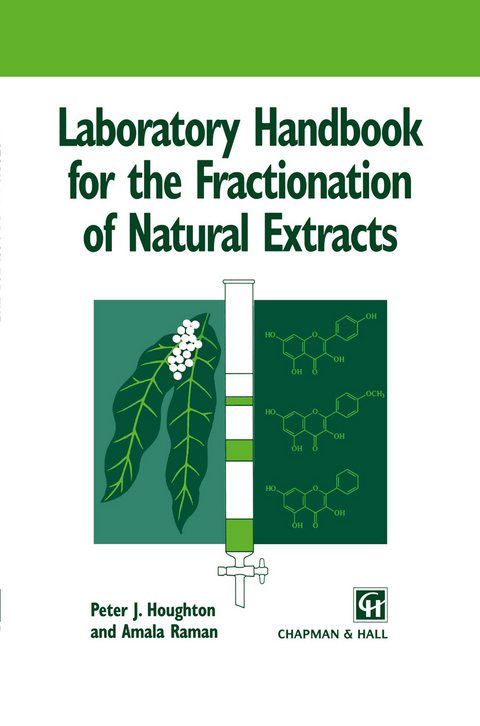
Laboratory Handbook for the Fractionation of Natural Extracts
Chapman and Hall (Verlag)
978-0-412-74910-0 (ISBN)
1. 1 THE NEEDFOR THIS BOOK- ANACTIVE EXTRACT, WHAT HAPPENS NEXT? All over the world at present there is greatactivity as scientists investi- gate plants, micro-organisms, marine creatures and many other forms of life for biological activity. There is a desire to find out more about the interactionsbetweenone organismand another which can be attributed to the chemical substances present in at least one of the species con- cerned. The area where activity has been greatest is the effect ofextracts from the flowering plantsonhuman physiology and human pathogens, since this is very relevant to the discovery ofnew drugs for treating dis- eases ofhumanbeings and other mammals. However, it should be noted thatother groups ofliving organisms are now being investigated for the same purposes and regular reports appear in the scientific literature which describe the activity of extracts and compounds isolated from marine organisms, amphibians, fungi and insects. Other types ofchemicallybased biological interactions are being stud- ied which have implications for otherways in which conditions canbe manipulated to serve thehuman race.
Thus, interactionsbetweenplants and insects may produce new pesticides or repellents, interactions between two species offlowering plantresultin herbicidalcompounds and the chemical interactionsbetween species have environmental impli- cations. This interdisciplinary science is sometimes called ecological chemistry and offers many fascinating insights into the complexity oflife onour planet. Many methods have beendevised whereby the activity ofa compound or extract can be tested scientifically.
1 Introduction.- 1.1 The need for this book — an active extract, what happens next?.- 1.2 Why is it important to find out the nature of the active components?.- 1.3 Green chemicals — the renewed interest in natural products as sources of bioactive compounds.- 1.4 What are we doing?.- 1.5 Bibliography.- 2 Important concepts.- 2.1 Introduction.- Polarity.- 2.3 Dilution and concentration factors.- 2.4 Synergy.- 2.5 Deterioration, decomposition and storage.- 2.6 Biological variation.- 2.7 Authentication of material.- 2.8 Dereplication.- 3 Methods for extraction and sample clean-up.- 3.1 Introduction.- 3.2 Factors to be considered in selecting an extraction method.- 3.3 General extraction methods.- 3.4 Extraction methods for specific phytochemical groups.- 3.5 Clean-up techniques to remove unwanted substances.- 3.6 Bibliography.- 4 Crude fractionation procedures.- 4.1 Introduction.- 4.2 Choice of fractionation method.- 4.3 Common fractionation methods.- 4.4 Bibliography.- 5 Chromatographic fractionation procedures.- 5.1 Introduction.- 5.2 The principles of chromatography.- 5.3 Physico-chemical processes taking place in chromatography.- 5.4 Bibliography.- 6 Chromatographic procedures using columns and liquid-liquid systems.- 6.1 Column chromatography.- 6.2 Liquid-liquid partition schemes.- 6.3 Bibliography.- 7 Layer chromatography.- 7.1 Layer chromatography.- 7.2 Preparative thin-layer chromatography and paper chromatography.- 7.3 Bibliography.- 8 Analysis of crude extracts, fractions and isolated compounds.- 8.1 Introduction.- 8.2 Qualitative analysis of mixtures and isolates.- 8.3 Quantitative analytical methods.- 8.4 Biological assays.- 8.5 Bibliography.- 9 General methods.- 9.1 Basic techniques in handling extracts.- 9.2 Isolation of active compounds.- 9.3Chromatographic procedures.- 9.4 Basic techniques in thin-layer chromatography.- 9.5 Bibliography.- 10 Practical exercises in chemical screening and fractionation of crude extracts from plant materials.- 10.1 Chemical screening.- 10.2 Exercises in extraction, clean-up, fractionation and Chromatographicmethods.- Appendix A Recipes for chemical test reagents.
| Zusatzinfo | VI, 199 p. |
|---|---|
| Verlagsort | London |
| Sprache | englisch |
| Maße | 155 x 235 mm |
| Themenwelt | Medizin / Pharmazie ► Medizinische Fachgebiete ► Pharmakologie / Pharmakotherapie |
| Naturwissenschaften ► Biologie ► Biochemie | |
| Naturwissenschaften ► Biologie ► Botanik | |
| ISBN-10 | 0-412-74910-6 / 0412749106 |
| ISBN-13 | 978-0-412-74910-0 / 9780412749100 |
| Zustand | Neuware |
| Haben Sie eine Frage zum Produkt? |
aus dem Bereich


